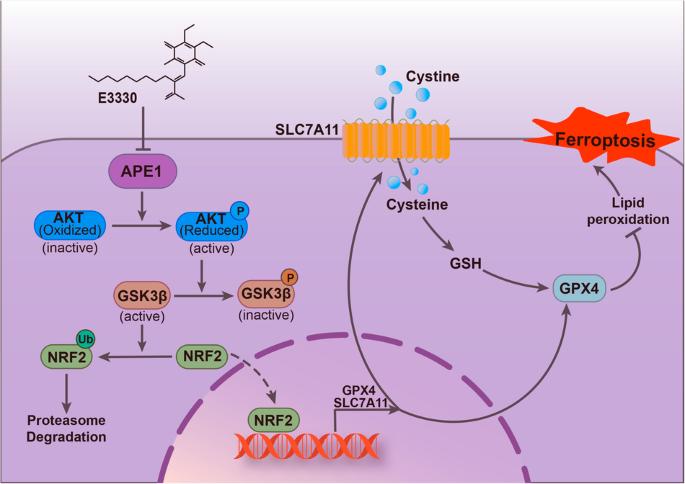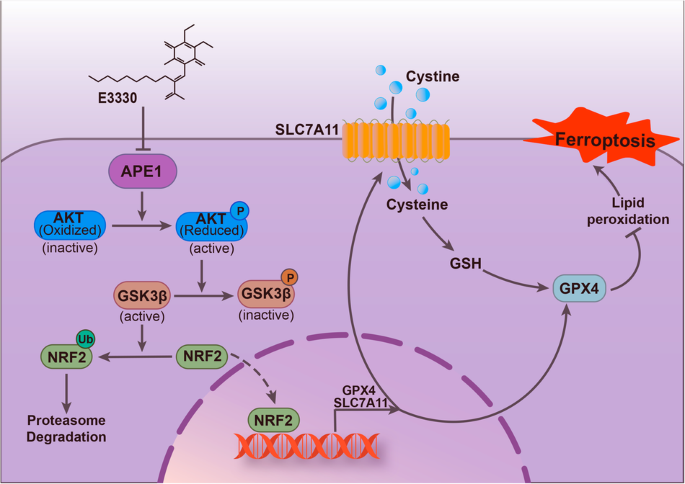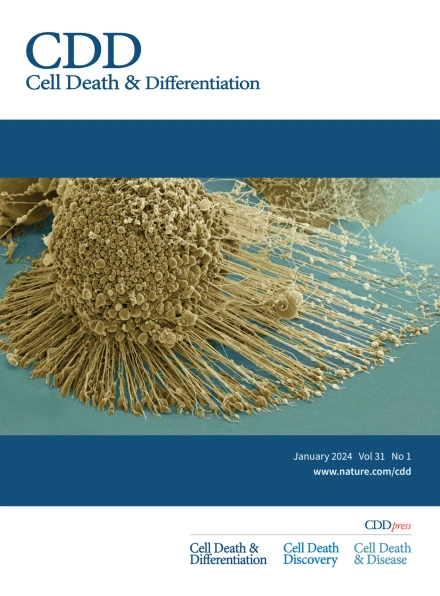抑制 APE1 可增强铁细胞死亡,有助于肝细胞癌的治疗。
IF 15.4
1区 生物学
Q1 BIOCHEMISTRY & MOLECULAR BIOLOGY
引用次数: 0
摘要
铁氧化是由铁依赖性脂质过氧化引发的一种细胞死亡调节形式,已成为一种很有前景的癌症治疗策略,尤其是在肝细胞癌(HCC)中。然而,HCC 中铁质过氧化的调控机制仍不清楚。在这项研究中,我们发现了一种新的铁凋亡调控途径,该途径涉及抑制 Apurinic/apyrimidinic endonuclease 1(APE1),APE1 是一种在 DNA 修复和氧化还原调控中具有双重功能的关键酶。我们的研究结果表明,抑制 APE1 会导致脂质过氧化物的积累,并增强 HCC 中的铁变态反应。在分子水平上,APE1的抑制增强了铁跃迁,而铁跃迁依赖于APE1通过调控NRF2/SLC7A11/GPX4轴的氧化还原活性。我们发现,遗传和化学抑制 APE1 都会增加 AKT 氧化,导致 AKT 磷酸化和活化受损,从而导致 GSK3β 的去磷酸化和活化,促进 NRF2 随后的泛素蛋白酶依赖性降解。因此,NRF2的下调抑制了SLC7A11和GPX4的表达,引发了HCC细胞中的铁变态反应,为基于铁变态反应的HCC治疗提供了一种潜在的治疗方法。总之,我们的研究揭示了 APE1 在调控铁氧化过程中的新作用和机制,并强调了靶向 APE1 作为 HCC 和其他癌症的一种有前景的治疗策略的潜力。本文章由计算机程序翻译,如有差异,请以英文原文为准。


APE1 inhibition enhances ferroptotic cell death and contributes to hepatocellular carcinoma therapy
Ferroptosis, a regulated form of cell death triggered by iron-dependent lipid peroxidation, has emerged as a promising therapeutic strategy for cancer treatment, particularly in hepatocellular carcinoma (HCC). However, the mechanisms underlying the regulation of ferroptosis in HCC remain to be unclear. In this study, we have identified a novel regulatory pathway of ferroptosis involving the inhibition of Apurinic/apyrimidinic endonuclease 1 (APE1), a key enzyme with dual functions in DNA repair and redox regulation. Our findings demonstrate that inhibition of APE1 leads to the accumulation of lipid peroxidation and enhances ferroptosis in HCC. At the molecular level, the inhibition of APE1 enhances ferroptosis which relies on the redox activity of APE1 through the regulation of the NRF2/SLC7A11/GPX4 axis. We have identified that both genetic and chemical inhibition of APE1 increases AKT oxidation, resulting in an impairment of AKT phosphorylation and activation, which leads to the dephosphorylation and activation of GSK3β, facilitating the subsequent ubiquitin-proteasome-dependent degradation of NRF2. Consequently, the downregulation of NRF2 suppresses SLC7A11 and GPX4 expression, triggering ferroptosis in HCC cells and providing a potential therapeutic approach for ferroptosis-based therapy in HCC. Overall, our study uncovers a novel role and mechanism of APE1 in the regulation of ferroptosis and highlights the potential of targeting APE1 as a promising therapeutic strategy for HCC and other cancers.
求助全文
通过发布文献求助,成功后即可免费获取论文全文。
去求助
来源期刊

Cell Death and Differentiation
生物-生化与分子生物学
CiteScore
24.70
自引率
1.60%
发文量
181
审稿时长
3 months
期刊介绍:
Mission, vision and values of Cell Death & Differentiation:
To devote itself to scientific excellence in the field of cell biology, molecular biology, and biochemistry of cell death and disease.
To provide a unified forum for scientists and clinical researchers
It is committed to the rapid publication of high quality original papers relating to these subjects, together with topical, usually solicited, reviews, meeting reports, editorial correspondence and occasional commentaries on controversial and scientifically informative issues.
 求助内容:
求助内容: 应助结果提醒方式:
应助结果提醒方式:


